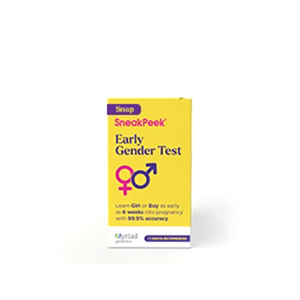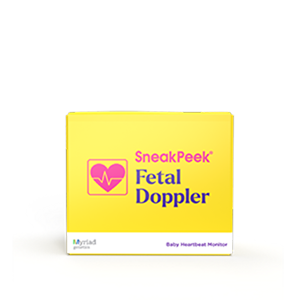Published on January 27th, 2022 and Updated on January 12th, 2024
Check out SneakPeek Gender Test to find out your baby’s gender as early as 6 weeks at over 99% accuracy1!
Could there be a sweeter sight in the world than your peaceful, perfect newborn finally getting some Zzzs? Sleep training is critical for a little one and for you. But as with other things that once seemed second nature before you became a parent, sleep may suddenly feel like foreign territory, clouded by doubt.
Instead of counting sheep at night, perhaps you’ve found yourself running through a long list of sleep-related questions and concerns. Perhaps, after you’ve lost hours to perfecting the swaddle or finding the bedroom temperature that’s juussst right, you’ve considered pacifiers—specifically, is it okay for your baby to sleep with one?
To put it simply, yes, it’s okay. According to the American Academy of Pediatrics (AAP), not only are pacifiers safe for bedtime, they’re recommended as a preventative measure against SIDS.
In this guide, we’ll explore everything you need to know about using pacifiers in your little one’s sleepytime routine.
Babies and Binkies: What You Need to Know
Whether it’s a cup of tea, a Netflix marathon, or a piping hot pizza, we all have something that we turn to for comfort. For your little one, that soothing something might be a newborn pacifier—and that’s perfectly normal!
Pacifiers—also known as soothers, dummies, and binkies—satisfy an innate impulse that many newborns experience: the impulse to suckle.
Many babies take comfort in suckling, whether they’re expressing a desire to feed, or just working out their reflexes through non-nutritive suckling—an expression of the suckling impulse that doesn’t have any relation to feeding.
By expressing this natural reflex, babies strengthen the muscles they need to get all of that nutritious, delicious breastmilk or formula.
Why suckle on a paci?
Made from rubber and designed to resemble a nipple, pacifiers are the perfect foil for your baby’s suckling reflex.
While it’s true that your little one will work out a lot of her impulses on your breast or the bottle, pacis accommodate faster suckling, making them a big hit with babies and parents who want to get that crying jag under control as soon as possible.
And studies confirm the popularity of these soothing items. In fact, between 60 and 85 percent of all babies use binkies.
When can baby use a pacifier?
Similar to the question, “when can a baby have a pillow”, there are no hard and fast rules about when it’s appropriate to give your little one a newborn pacifier. Whether you give your newborn a pacifier right away or hold off for a few weeks, there’s no reason to say that either is unsafe or harmful.
Pacifiers don’t encourage unnatural behavior in infants. Rather, they work by satiating natural needs. After all, your little guy’s been working out these reflexes since before he was born. Remember that adorable ultrasound photo where he’s oh-so-sweetly suckling his tiny thumb? See? Natural.
That said, if you’re trying to establish a breastfeeding routine, you might find it helpful to keep the binkie in the drawer while you and your sweet boy settle into a rhythm.
Here’s why:
- Nipple confusion – It turns out that one of the things that your little one may love the most about a binky—that it resembles a nipple—may also introduce an element of nipple confusion as he learns his way around the real thing.
If a breastfed baby finds suckling on the paci easier than feeding or becomes accustomed to the shape of the paci before he or she is used to your breast, there’s a small chance he or she may have trouble latching. The breast fed baby may also feel less interested when it’s time to eat.
- Milk supply – A binky can be a saving grace when a breastfed infant is inconsolable, and you need to give your breasts a rest–especially if you’re not sure why he’s crying. Hunger? Exhaustion? Just because?
However, leaning on the pacifier to soothe his sobs too often might result in reduced feeding, which can leave him without enough nourishment and you with a diminished milk supply.
To avoid these issues, you might want to stick to these feeding-based timelines to determine when to introduce a pacifier to your baby:
- Breastfeeding with no problems latching – According to the AAP, if you haven’t run into any trouble with latching, you should be fine introducing the pacifier to your baby when he’s 2 to 4 weeks old.
- Breastfeeding with problems latching– If your little mister is struggling to latch, you might benefit from holding off on paci use until he gets the breast down pat.
- Bottle feeding – One underrated perk of bottle feeding? You can give your baby boy a paci whenever it feels right to you. The rubber nipples on binkies closely resemble the nipples on baby bottles, so you won’t have to worry about any mealtime confusion or suckling issues.
Can she use a pacifier while she sleeps?
Like lullabies, bedtime stories, and that adorable pink giraffe sleep sack, binkies can make wonderful bedtime companions for your little one and you.
You might think to turn to a pacifier to calm your baby’s cries, but pacifiers also come in handy when she isn’t crying—as a part of her sleepytime routine. In fact, many parents turn to pacifiers to help their babies doze off (so they can, too).
If you’ve already introduced your little one to the paci, there’s no reason to avoid using it for bedtime. Bedtime pacifier use has been supported by several medical studies and comes with a strong recommendation from the Academy of American Pediatrics.
The reason why goes beyond the pacifier’s ability to promote suckling and foster a sense of calmness. Bedtime binkie use has proven instrumental in preventing SIDS, or Sudden Infant Death Syndrome—the unexplained death of an infant under 1-year-old.
SIDS and Sleep
Sudden Infant Death Syndrome, or SIDS, weighs heavily on many new parents—inspiring understandable worry during a time that’s already defined by healthy doses of anxiety.
It’s worth noting, however, that SIDS is extremely rare, occurring in only .0034 percent of infants in the United States. Moreover, researchers have made undeniable headway in unpacking the various factors that may contribute to SIDS, including:
- Stomach and side sleeping
- Bed-sharing
- Overheating
- Sleeping on a soft surface
- Exposure to secondhand smoke
Public health officials have also made strides by effectively communicating ways that parents can reduce the risk at home. These include:
- Putting baby on her back to sleep
- Knowing the best temperature for a baby’s sleep
- Having her sleep in your room
- Making sure her crib is empty (no blankies or stuffed animals)
Also, on that list? Putting her to bed with a pacifier.
How Pacifiers Can Help Prevent SIDS
While the root causes of SIDS are complex and difficult to determine with certainty, experts believe that it may occur when infants have difficulty rousing themselves from a deep sleep and fail to take in a sufficient amount of oxygen.
Although the reasons that pacifiers help with SIDS prevention have yet to be explicitly spelled out, many theorize that the soothers combat SIDS risks in three distinct ways:
- Pacifiers prevent deep sleep – When your little miss is sucking away on her paci through the night, it’s likely that—although she’ll be cozy and content—she won’t enter deep sleep. That means that she’ll be able to wake herself if she runs into any trouble breathing.
- Pacifiers keep her on her back – With a binkie in her mouth and not a care in the world, your little one is de-incentivized to roll onto her tummy (a position that she might naturally turn to for comfort but that is associated with higher SIDS risk). A paci may also provide a buffer from the mattress if she does rollover, which can help prevent suffocation.
- Pacifiers build her breathing muscles – Working out isn’t just important for mom and dad. It turns out that your baby benefits from regular exercise, too. Using a pacifier may help her stretch and strengthen her breathing muscles and nerve reflexes, which are integral to safe sleep.
The Rest Is Up to You: Incorporating Pacifiers into Your Sleepytime Ritual
If you find yourself asking, “Can baby sleep with a pacifier?” rest assured that it’s perfectly normal and healthy. Not only can babies sleep with their binkies, but many experts also believe that they should. Incorporating a pacifier into your bedtime ritual can help your little one sleep more safely, and help you sleep more soundly.
Keep in mind, the AAP does recommend that you begin to wean him off of the paci around the time he turns 1 year old. This may be right around the time that he starts using it as a chew toy instead of a safe-sleep instrument.
Otherwise, the rest is up to you. When and if you give your baby a binkie is personal and depends on his needs, as well as your own.
For the Dreamiest Sleep—SneakPeek
Pacifiers can be your best bud if you’re looking for extra sleepytime support. They can help ease your little one into a restful slumber so you can establish a healthy sleep routine. Plus, an easier bedtime means you’ll have more time to recharge, refresh, and finally crack open that novel you picked for book club.
If you’re looking for another tool you can use to establish a healthy sleep routine and set your child up for a lifetime of sleep success, look no further than SneakPeek’s helpful Mommy blog.
This post has been reviewed for accuracy by the following medical professional:
Katie Smith is a seasoned Certified Nurse Midwife and a nurturing mother to six children, offering a unique blend of professional expertise and personal experience. She is the founder of Birth Your Way Midwifery and Women’s Wellness Center in Bay County, Florida. Katie's comprehensive approach to care is informed by her hands-on experience in motherhood and her passion for empowering women through their birthing journey. Her dedication extends beyond her center as she actively engages in community wellness and family health education.
Sources:
- Academy of American Pediatrics. SIDS and Other Sleep-Related Infant Deaths: Updated 2016 Recommendations for a Safe Infant Sleeping Environment. https://publications.aap.org/pediatrics/article/138/5/e20162938/60309/SIDS-and-Other-Sleep-Related-Infant-Deaths-Updated
- Healthline. Here’s What You Need to Know About Popping in Pacifiers to Soothe Newborns. https://www.healthline.com/health/parenting/newborn-pacifier#Why-are-pacifiers-such-a-big-deal?
- The Bump. The Pros and Cons of Pacifier Use. https://www.thebump.com/a/pacifier-pro-and-con
- Infant CPR. Pacifier Safety—Can Newborns Sleep with Pacifiers? https://infantcpr.com/blog/posts/sleeping-with-pacifier/
- Journal of Pediatrics and Child Health. Dummy (pacifier) use and sudden infant death syndrome: Potential advantages and disadvantages. https://onlinelibrary.wiley.com/doi/full/10.1111/jpc.12402
- Mayo Clinic. Sudden infant death syndrome (SIDS). https://www.mayoclinic.org/diseases-conditions/sudden-infant-death-syndrome/symptoms-causes/syc-20352800
- CDC. Sudden Unexpected Infant Death and Sudden Infant Death Syndrome Data and Statistics. https://www.cdc.gov/sids/data.htm
- Boston Children’s Hospital. Sudden Infant Death Syndrome Symptoms and Causes. https://www.childrenshospital.org/conditions-and-treatments/conditions/s/sudden-infant-death-syndrome-sids/symptoms-and-causes
- Lil Baby Sleep. Pacifiers: To Suck or Not to Suck. https://www.lilbabysleep.com/blog/2019/9/29/pacifiers-to-suck-or-not-to-suck

Shop Our Products
SneakPeek aims to provide the most accurate and up-to-date information to help our readers make informed decisions regarding their health before, during, and after pregnancy. This article was written based upon trusted scientific research studies and/or articles. Credible information sources for this article are cited and hyperlinked.






